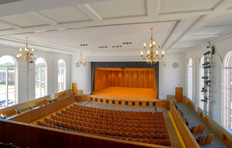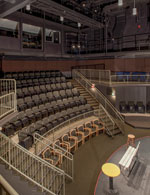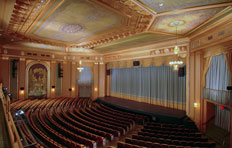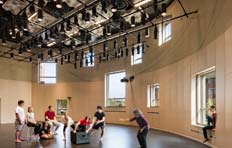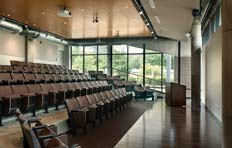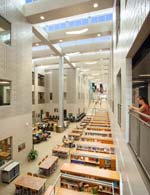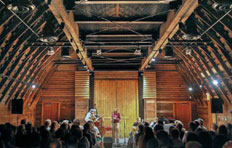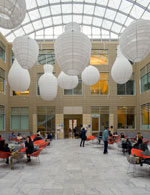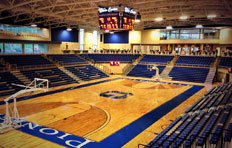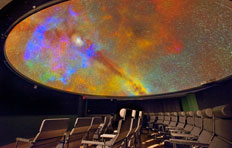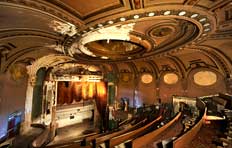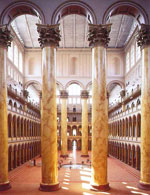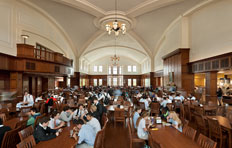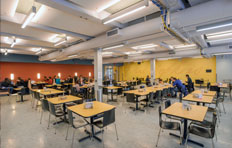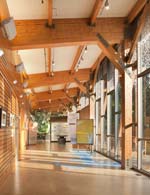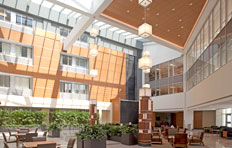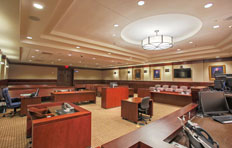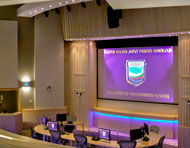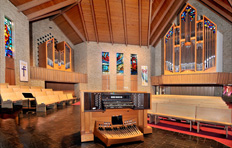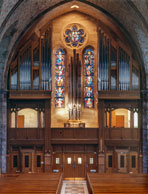Drama and Musical Arts
Drama and music facilities are where art and science merge to provide an environment for artistic expression. Good acoustics and theater planning are central to the function of these buildings. Appropriate design unifies technical and functional aspects for patrons, performers, and management.
Room acoustics, noise control, sound isolation, audio/visual, and theater systems are specified for the unique programming of each venue.
Concert and Recital Halls
Traditionally, reverberance has been the primary acoustic consideration for concert and recital halls. Contemporary research suggests factors based on the ratio of early-to-late sound more closely relates to the perception of ‘good acoustics’. Room shaping and geometry affect these parameters and can be optimized through computer modeling. Click images to enlarge.
Elizabeth City Opera House – Elizabeth City, NC
Owner: Arts of Albemarle, Inc.
Architect: Clearscapes, Inc.
Description: Renovation and expansion of an 1890s historic theater into a multi-use visual and performing arts center with a 650-seat theater on the second floor and galleries and studios on the first floor.
Services: Audio/visual systems, equipment noise control, room acoustics, and sound isolation.
Challenges: Gaining acceptance from the local historic preservation agency for the audio/visual system concept in the theater.
Gibson Performing Arts Center Recital Hall – Chestertown, MD
Owner: Washington College
Architect: GWWO, Inc./Architects
Description: New 215-seat recital hall featuring a glass exterior wall designed as part of a larger performing arts complex.
Services: Computer modeling, equipment noise control, room acoustics, and sound isolation.
Challenges: Designing sound diffusing surfaces for the concave side walls to avoid sound focusing without using sound absorptive materials that would reduce room reverberance.
Hall of Musical Instruments – Washington, DC
Owner: Smithsonian Institution
Architect: EwingCole
Description: Renovation of an existing recital hall into an intimate 170-seat venue for performances featuring the Smithsonian Institution’s collection of historic keyboards and Cremonese string instruments.
Services: Acoustic measurements, equipment noise control, room acoustics, sound isolation, and theater systems.
Challenges: Design of box-within-box sound isolation construction to fit within the allocated space constraints.
Maryland Hall for the Creative Arts – Annapolis, MD
Owner: Maryland Hall for the Creative Arts
Architect: Ziger/Snead Architects LLP
Description: Renovation of an existing 850-seat auditorium used for ballet, choral, opera, and symphony performances to include stage shell and overhead canopy, new backstage areas, new 250-seat community theater, and patron hospitality spaces.
Services: Acoustic measurements, audio/visual systems, computer modeling, equipment noise control, room acoustics, and sound isolation.
Challenges: Designing the stage overhead canopy to provide a balance of early sound reflections and appropriate on-stage sound levels.
Drama Theaters
Drama theaters need to engage the audience to create the sense of magic that defines the performance. Acoustic and visual intimacy are crucial for engaging performers and audience. Short reverberance, supportive sound reflections, low noise levels, and theater lighting are crucial to convey the actor’s art. Click images to enlarge.
Gibson Performing Arts Center Experimental Theater – Chestertown, MD
Owner: Washington College
Architect: GWWO, Inc./Architects
Description: New 175-seat black box theater designed as part of a larger performing arts complex based on a modified courtyard seating plan that brings the audience close to the stage.
Services: Computer modeling, equipment noise control, room acoustics, and sound isolation.
Challenges: Developing sound isolation for the upstage wall adjacent to a main corridor with several entrance doors into the theater.
Hershey Area Playhouse – Hershey, PA
Owner: Hershey Area Playhouse
Architect: Alexander Design Studio
Description: Conversion of Civil War era horse barn into a contemporary 250-seat
community playhouse.
Services: Equipment noise control, room acoustics, and sound isolation.
Challenges: Designing sound diffusing wall surfaces that provide low-frequency sound absorption.
Shakespeare Theater – Washington, DC
Owner: Folger Shakespeare Library
Architect: Direct to owner
Description: Renovation of a 200-seat Shakespearean theater.
Services: Acoustic measurements, equipment noise control, room acoustics, and sound systems.
Challenges: Determining change in reverberance by removing 2 inches of dust above a ceiling tapestry covering the audience seating.
Multi-Purpose Auditoria
Multi-purpose auditoria have the challenge of accommodating performances with varying acoustic and theatrical requirements. Adjustable acoustic systems and appropriate theater equipment can adapt auditoria to specific performances and become more profitable for venue managers. Click images to enlarge.
Fluvanna High School Auditorium – Palmyra, VA
Owner: Fluvanna County Public Schools
Architect: BCWH
Architects
Description: New 150,000 SF high school designed to the LEED® Silver standard including a 1,200-seat multi-purpose auditorium used for school and community activities.
Services: Computer modeling, equipment noise control, room acoustics, and sound isolation.
Challenges: Shaping the auditorium ceiling and wall surfaces to improve level and timing of sound reflections to the audience.
Henrico Theater – Highland Springs, VA
Owner: Henrico County
Division of Recreation and Parks
Architect: Guernsey Tingle Architects
Description: Renovation of an abandoned art-deco movie theater into a 450-seat community arts center.
Services: Audio/visual systems, computer modeling, equipment noise control, room acoustics, and sound isolation.
Challenges: Integrating the acoustic design to comply with historic preservation guidelines and audio/visual systems design for lectures, movies, and music.
Ocean City Performing Arts Center – Ocean City, MD
Owner: Town of Ocean City
Architect: GWWO, Inc./Architects and Becker Morgan Group, Inc.
Description: New 1,200-seat multi-purpose auditorium used for drama, music, and conference meetings.
Services: Computer modeling, equipment noise control, room acoustics, and sound isolation.
Challenges: Reducing reverberance due to the excessively high ceiling used to match the exterior building massing.
Paramount Theater – Charlottesville, VA
Owner: Paramount Theater of Charlottesville, Inc.
Architect: Martinez & Johnson Architecture
Description: Renovation and expansion of a 1931 Rapp & Rapp movie palace into a 1,000-seat multi-purpose auditorium and community center.
Services: Acoustic measurements, audio/visual systems, computer modeling, equipment noise control, room acoustics, and sound isolation.
Challenges: Developing HVAC equipment noise and vibration control with equipment located in the attic above the audience seating.
Rehearsal Rooms
Rehearsal rooms require individual and group performers to be judged for correct ensemble, diction, intonation, rhythm, and movement. Adjustable reverberance and sound isolation are necessary. Audio/visual systems, theater lighting, and visual monitoring help artists realize their performance objectives. Click images to enlarge.
Frank Arts Center – Shepherdstown, WV
Owner: Shepherd University
Architect: GWWO, Inc./Architects
Description: New 200-seat music rehearsal room and nine music practice rooms with electronic acoustic enhancement systems.
Services: Equipment noise control, room acoustics, and sound isolation.
Challenges: Developing suitable room volume and acoustic finishes for the music rehearsal room to reduce sound levels when the marching band rehearses.
Performing Arts and Humanities Building – Catonsville, MD
Owner: University of Maryland Baltimore County
Architect: William Rawn Associates and Grimm and Parker
Description: New performing arts and humanities building with music and drama rehearsal rooms, recording studio, faculty studios, and support spaces. Acoustic Consulting Services provided to Convergent Technology Design Group.
Services: Equipment noise control, room acoustics, and sound isolation.
Challenges: Designing the rehearsal rooms for different performance groups and repertoire while working with a limited budget.
Sitar Center for the Arts – Washington, DC
Owner: Sitar Center for the Arts
Architect: Inscape Studio
Description: New community visual and performing arts center with 50-seat recital hall, music practice rooms, dance studio, and classrooms located in the basement of a condominium building.
Services: Equipment noise control, room acoustics, and sound isolation.
Challenges: Specifying sound isolation construction between the performing arts center and the condominium residences above.
Education
Education buildings require conditions that foster information conveyance for learners of all ages. Good hearing and viewing conditions can improve comprehension and retention by up to 60 percent.
Suitable room reverberance, low HVAC noise levels, adequate loudness for the spoken word, and good sightlines contribute to an effective learning environment.
College/University
The breadth of buildings on campus corresponds to a diversity of acoustic requirements. Changing instructional trends, particularly interactive learning, are reflected in greater reliance on audio/visual and IT equipment and room acoustic quality. Click images to enlarge.
Knott Science Center – Baltimore, MD
Owner: College of Notre Dame of Maryland
Architect: Melville Thomas Architects
Description: New 215-seat lecture hall as part of a larger pharmacy school renovation.
Services: Equipment noise control, room acoustics, and sound isolation.
Challenges: Developing sound isolation for the mechanical equipment room located behind the front wall.
Eugene W. Leake Hall – Baltimore, MD
Owner: Maryland Institute College of Art
Architect: Hord | Coplan | Macht
Description: New 88,000 SF building with black box theater, 300-seat lecture hall, art studios, and student residences.
Services: Equipment noise control, room acoustics, sound isolation, and theater systems.
Challenges: Sound isolation for student residences above the black box theater and art studios.
Robert H. McKinney School of Law – Indianapolis, IN
Owner: Indiana University Purdue University-Indianapolis
Architect: SmithGroupJJR
Description: New
230,000 SF law school with moot courtrooms, 40, 60, and 100-seat lecture halls, and a 300-seat auditorium.
Services: Equipment noise control, room acoustics, and sound isolation.
Challenges: Selecting room acoustic finishes in the 300-seat auditorium and 100-seat lecture halls.
Torgersen Hall – Blacksburg, VA
Owner: Virginia Polytechnic Institute and State University
Architect: Esocoff Associates Architects
Description: New 150,000 SF advanced communications technology center with classrooms, multi-media laboratories, 150-seat lecture hall, 300-seat auditorium, and an electronic study court atrium.
Services: Equipment noise control, room acoustics, and sound isolation.
Challenges: Determining HVAC equipment noise control that did not use acoustic duct lining.
Photo Credit: © Maxwell MacKenzie
Conference Centers
Conference centers include exhibition halls, breakout rooms, hospitality spaces, and in some cases, auditoria. Sound isolation for operable walls and intelligible voice paging and emergency warning systems promote a satisfactory experience for exhibitors and attendees. Click images to enlarge.
Boar's Head Inn Meeting Pavilion – Charlottesville, VA
Owner: University of Virginia
Architect: Glavé and Holmes Architecture
Description: New 18,000 SF conference and meeting center with subdivisible ballroom, breakout meeting rooms, pre-function space, and commercial kitchen.
Services: Audio/visual systems, equipment noise control, room acoustics, and sound isolation.
Challenges: Noise control planning for exterior-located equipment to satisfy local residents and conform to the local noise ordinance.
Council on Foreign Relations – Washington, DC
Owner: Council on Foreign Relations
Architect: Mancini Duffy
Description: New 60,000 SF policy group headquarters building with closed offices, open-plan offices, 75-seat and 150-seat conference rooms, TV studio, and cafeteria.
Services: Equipment noise control, room acoustics, and sound isolation.
Challenges: Developing sound isolation for custom-designed conference room doors.
Pan American Health Organization Knowledge Center – Washington, DC
Owner: Pan American Health Organization
Architect: Karn Charuhas Chapman & Twohey
Description: Renovation of 15,000 SF office space into an emergency response center including a 45-seat video-teleconference center, conference rooms, and offices.
Services: Equipment noise control, room acoustics, and sound isolation.
Challenges: Selecting acoustic finishes for the round video-teleconference center to reduce sound focusing.
K-12 Schools
Many school districts are adopting the ANSI S12-60 or USGBC LEED® acoustic standards based on evidence that good classroom acoustic conditions can positively affect student learning. These standards include minimum requirements for reverberation time, sound isolation, and HVAC system noise for core learning spaces. Click images to enlarge.
Baltimore School of Design – Baltimore, MD
Owner: Baltimore City Public Schools
Architect: Ziger/Snead Architects LLP
Description: Renovation of a 115,000 SF industrial building into the nation’s first public middle and high school for architecture, arts, fashion, and graphic design.
Services: Equipment noise control, room acoustics, and sound isolation.
Challenges: Reverberation control in classroom spaces with 14 ft ceilings to maintain the existing industrial appearance.
Carey Hall – Baltimore, MD
Owner: Gilman School
Architect: Ziger/Snead Architects LLP
Description: Renovation and addition of a 1920s building to include classrooms, lecture hall, library, art studios, gallery space, and industrial education shops.
Services: Equipment noise control, room acoustics, and sound isolation.
Challenges: Noise control for industrial arts classrooms.
Dundalk-Sollers Point High School – Essex, MD
Owner: Baltimore County Public Schools
Architect: GWWO, Inc./Architects
Description: New 365,000 ft2 high school with a 650-seat auditorium and vocational education school designed to the LEED® Silver Standard.
Services: Audio/visual systems, equipment noise control, room acoustics, and sound isolation design.
Challenges: Reverberation control for the three-story atrium extending along the building central corridor.
Entertainment
Entertainment establishments, whether part of a mixed-use development or a stand-alone building, are commonly located near residences to create vibrant communities. These venues typically operate at night when residents desire quiet.
Planning agencies may set strict noise emission limits that affect building construction. Of particular concern is the ‘bass beat’ that travels easily through structures and is noticeable even at moderately low levels.
Amusement
Noise from amusement activities covers many amplified and non-amplified sources. Sound propagation, factoring the spectral character of the source, enables appropriate acoustic finishes and sound isolation to be specified. Click images to enlarge.
Barns of Rose Hill – Berryville, VA
Owner: Barns of Rose Hill, Inc.
Architect: Carter + Burton
Description: Conversion of two early 20th Century dairy barns into a performing arts venue, education center, and community art gallery.
Services: Equipment noise control, room acoustics, and theater systems.
Challenges: Developing noise control for the HVAC system to reduce property line noise immissions.
Gilman Hall – Baltimore, MD
Owner: Johns Hopkins University
Architect: R.M. Kliment and Frances Halsband Architects
Description: Renovation and expansion designed to the LEED® Gold Standard of a 146,000 ft2 1906 Neo-Colonial building designed by Parker and Thomas with classrooms, two 75-seat lecture halls, 210-seat auditorium, film screening room, archaeological museum, and a three-story atrium with a coffee bar and entertainment facilities.
Services: Equipment noise control, room acoustics, and sound isolation.
Challenges: Developing atrium acoustic finishes to be discreetly placed behind the terra-cotta rain screen.
National Zoo Seal and Sea Lion House – Washington, DC
Owner: Smithsonian Institution
Architect: Quinn Evans Architects
Description: Design of a new habitat for North American seals and sea lions enabling the public to view the animals in their natural setting.
Services: Equipment noise control, sound isolation, sustainable design, and vibration isolation.
Challenges: Developing custom sound attenuators for the large water wave fan to conform to the District of Columbia Noise Ordinance.
Arenas
Arenas used for sports, entertainment, and concert events are typically reverberant due to the large room volume. Acoustic treatments for reverberation control, a sound system for announcements, event commentary, and music playback, and video image magnification can improve the spectator experience. Click images to enlarge.
Michael J. Hagen Arena – Philadelphia, PA
Owner: St. Joseph's University
Architect: Burt Hill Architects
Description: Renovation and expansion of an athletic center including a 4,000-seat basketball arena, lobby, team rooms, and physical education classrooms.
Services: Equipment noise control, room acoustics, and sound isolation.
Challenges: Developing sound absorptive treatments for the arena and lobby that are acoustically coupled together as one larger space.
Ritchie Coliseum – College Park, MD
Owner: University of Maryland
Architect: Ayers/Saint/Gross
Description: Renovation of a 1930’s athletic center including a 2,000-seat gymnasium, dance studios, exercise rooms, and martial arts rooms.
Services: Audio/visual systems, equipment noise control, room acoustics, and sound isolation.
Challenges: Integrating acoustic materials compatible with the architect’s desire to maintain the appearance of the original building finishes.
Waco Center – Glenville, WV
Owner: Glenville State College
Architect: Associated Architects and Edward Tucker Architects, Inc.
Description: Design of a new multi-purpose building with classrooms, health center, athletic department offices, and a 3,300-seat arena used for sports and convocation ceremonies.
Services: Audio/visual systems, equipment noise control, room acoustics, and sound isolation.
Challenges: Developing audio/visual system loudspeakers and scoreboard projection system for the arena.
Photo Credit: ©Parkersburg News and Sentinel
Movie Theaters
Movie theaters, whether a local art house or a national chain, have requirements for room acoustics, sound isolation, HVAC noise levels, and audio/visual systems, particularly if the venue seeks industry-standard certification established by Dolby®, THX®, and others. Click images to enlarge.
Robinson Nature Center IMAX Theater – Columbia, MD
Owner: Howard County Recreation and Parks
Architect: GWWO, Inc./Architects
Description: New 50-seat digital movie theater and planetarium within a new 26,000 SF nature center.
Services: Equipment noise control, room acoustics, and sound isolation.
Challenges: Developing sound and vibration isolation for the movie theater sound system.
Stavros Niarchos Foundation Film Center – Baltimore, MD
Owner: Maryland Film Festival
Architect: Ziger/Snead Architects LLP
Description: Renovation and expansion of a 1915 Italian Renaissance movie palace designed by Oliver Birkhead Wight into an independent film center with a 420-seat movie theater, and two 90-seat screening rooms, large multi-purpose room, and restaurant and bar facilities.
Services: Equipment noise control, room acoustics, and sound isolation.
Challenges: Developing floating sound isolation construction for the vertically stacked screening rooms.
Photo Credit: © Amy Davis
The Senator Theatre – Baltimore, MD
Owner: The Senator Theatre, LLC
Architect: Castro/Arts
Description: Renovation and expansion of an 800-seat 1939 movie palace designed by John Jacob Zink into the original art-deco style with three smaller screening rooms and a wine bar.
Services: Audio/visual systems, equipment noise control, room acoustics, and sound isolation.
Challenges: Selecting and acoustic testing different fabrics to cover sound absorptive finishes in the movie theaters.
Photo Credit: © Amy Davis
Museums
Museums include both static exhibits and interactive ‘infotainment’ environments using audio/visual equipment. Galleries require controlling reverberance, patron activity noise, and exhibit audio sound transmission. Larger institutions may have lecture rooms, recital halls, or viewing theaters with specific acoustic criteria. Click images to enlarge.
International Spy Museum – Washington, DC
Owner: The Malrite Company
Architect: SmithGroupJJR
Description: Renovation of three townhouses and new building construction for 20 interactive exhibits, 250-seat multi-purpose room, two 100-seat theaters, and museum shop.
Services: Audio/visual systems, equipment noise control, room acoustics, and sound isolation.
Challenges: Integrating acoustic finishes in the gallery spaces and sound isolation for the multi-purpose room adjacent to condominium units.
National Building Museum – Washington, DC
Owner: National Building Museum
Architect: Karn Charuhas Chapman & Twohey
Description: Renovation of 20 exhibit spaces in an 1887 Italian Renaissance Revival building designed by Montgomery C. Meigs.
Services: Equipment noise control, room acoustics, and sound isolation.
Challenges: Selecting sound absorptive finishes to match the vaulted ceiling geometry and noise control for the gallery custom air handler units.
Reynolds Museum and Education Center – Mt. Vernon, VA
Owner: Mt Vernon Ladies' Association
Architect: GWWO, Inc./Architects
Description: New 41,000 SF museum comprising 21 galleries, 100- and 250-seat theaters, and two distance learning rooms.
Services: Acoustic measurements, equipment noise control, room acoustics, and sound isolation.
Challenges: Developing sound isolation for the auditoria above the building mechanical equipment room.
Living
Living facilities include accommodations for dining, housing, and shopping serving different clientele and markets. Research shows that noise affects people’s mental and physical well-being, with over 20 percent of the population adversely affected.
Sound isolation and interior acoustic qualities contribute to a habitable and enjoyable place and can be based on custom or standardized construction materials and techniques.
Dining
A formal restaurant may need relative quiet in contrast to a casual café that is better suited to a vibrant acoustic. Talkers raise their voice when background noise increases, making for uncomfortably loud conditions. A newly defined concept, ‘acoustical capacity’, enables restaurant acoustic properties to be calculated so the desired ambiance is achieved. Click images to enlarge.
Edward St John Student Center – Owings Mills, MD
Owner: McDonogh School
Architect: Bowie Gridley Architects
Description: Design of a new 72,000 SF student center with 650-seat dining hall, 175-seat lecture hall/theater, art classrooms and galleries, dance studio, and faculty offices.
Services: Equipment noise control, room acoustics, and sound isolation.
Challenges: Selecting materials to control sound focusing and room reverberation in the dining hall.
Levering Dining Hall – Baltimore, MD
Owner: Johns Hopkins University
Architect: Read and Company Architects, Inc.
Description: Renovation of a cafeteria to include food servery and dining rooms.
Services: Acoustic measurements and room acoustics.
Challenges: Selecting ceiling sound absorptive finishes to satisfy architect’s design vision and owner’s acoustic design goals.
Zola Restaurant – Washington, DC
Owner: The Malrite Company
Architect: Adamstein and Demetriou
Architects
Description: New themed ‘white linen’ restaurant and bar within a museum.
Services: Room acoustics and sound isolation.
Challenges: Designing room layout and selecting acoustic finishes to maximize speech privacy between tables.
Photo Credit: © Max MacKenzie
Residential
Home should provide for peace and quiet. Noise is a major consideration for elder care, hotels, multi-family, and student housing. Building Codes contain minimum interior sound isolation standards and residential buildings are subject to exterior noise assessments when located near transportation sources. Click images to enlarge.
Belgian Ambassador's Residence – Washington, DC
Owner: Belgian Ministry of Foreign Affairs
Architect: Quinn Evans Architects
Description: Renovation of a 9,000 SF Beaux-Arts diplomatic residence for state functions and family living.
Services: Equipment noise control and sound isolation.
Challenges: Integrating noise control for new mechanical systems serving the living quarters.
Miller & Rhoads Building – Richmond, VA
Owner: MRI Properties, Inc.
Architect: Commonwealth Architects
Description: Renovation of a former 475,000 SF department store into a mixed-use complex including condominiums, retail, and a 250-suite Hilton Gardens Inn.
Services: Equipment noise control, room acoustics, and sound isolation.
Challenges: Determining required sound isolation for 11 different floor/ceiling constructions throughout the building.
Yuma Study Center – Washington, DC
Owner: Opus Dei
Architect: Quinn Evans Architects
Description: Renovation and expansion of a former 1927 Italianate style convent designed by Maurice F. Moore into a 50,000 SF women’s living center with two chapels, classrooms, dormitory rooms, offices, and a multipurpose room.
Services: Acoustic measurements, equipment noise control, room acoustics, and sound isolation.
Challenges: Integrating acoustic finishes in the chapels and noise control for mechanical systems located below each chapel.
Past, Present, Future
Acoustics continues to evolve as building construction and technologies change, and not the least, as human response to sound is better understood.
Regardless of age, buildings have the express need to function effectively for their occupants. To meet the challenges of the past, present, and future requires a broad understanding of acoustics, architecture, and building systems.
Historic Preservation
Older buildings provide a link to a community’s past and can be economically advantageous compared to new construction. Historic preservation has the objective of integrating acoustic materials, sound isolation, and noise control elements to blend seamlessly with the original while upgrading the building to modern standards. Click images to enlarge.
Enoch Pratt Free Library – Baltimore, MD
Owner: Baltimore City Government
Architect: Beyer Blinder Belle
and Ayers/Saint/Gross
Description: Renovation of a 300,000 SF main city library designed by Clyde Fritz and the design of a new 45,000 SF expansion wing and children’s annex.
Services: Equipment noise control, room acoustics, and sound isolation.
Challenges: Developing sound isolation for special collections rooms and selecting acoustic finishes for the concave ceiling in the children’s reading room.
First and Franklin Street Presbyterian Church – Baltimore, MD
Owner: First and Franklin Street Presbyterian Church
Architect: Murphy & Dittenhafer, Inc.
Description: Renovation of an 1856 ‘Flamboyant Gothic’ 600-seat sanctuary designed by Gershom Norris Starkweather.
Services: Acoustic measurements, audio/visual systems, equipment noise control, room acoustics, and sound isolation.
Challenges: Developing sound isolation for the attic mechanical equipment room and sanctuary HVAC system noise control.
Roosevelt Hall National Defense University – Washington, DC
Owner: US Government
Architect: Ellerbe Becket
Description: Renovation of a 102,000 SF building designed by McKim, Mead, and White with a 550-seat auditorium, three-story library, classrooms, and offices constructed using Guastavino tile vaults.
Services: Acoustic measurements, audio/visual systems, equipment noise control, room acoustics, and sound isolation.
Challenges: Designing the auditorium audio/visual systems to integrate the loudspeakers within the room.
Sustainability
Buildings account for nearly 30 percent of greenhouse gas emissions. Sustainability initiatives preserve the planet’s finite resources through conscientious planning. Sustainability standards, such as Green Globes, IgCC, and LEED®, include acoustics to provide a holistic environment for occupants. Click images to enlarge.
Cylburn Arboretum Vollmer Center – Baltimore, MD
Owner: Baltimore City Government
Architect: GWWO, Inc./Architects
Description: New 10,000 SF orientation and meeting center including a 250-seat multi-purpose room.
Services: Audio/visual systems, equipment noise control, room acoustics, sound isolation, and sustainable design.
Challenges: Developing video projection systems to display legacy media and custom-designed program audio loudspeakers.
Robinson Nature Center – Columbia, MD
Owner: Howard County Recreation and Parks
Architect: GWWO, Inc./Architects
Description: New 26,000 SF nature center comprising galleries, 150-seat multi-purpose room, 50-seat IMAX movie theater and planetarium, conservation areas, and offices designed to conform to the LEED® Platinum standard.
Services: Equipment noise control, room acoustics, sound isolation, and sustainable design.
Challenges: Selecting room acoustic materials based on low-cost and recycled content.
USGBC Headquarters – Washington, DC
Owner: United States Green Building Council
Architect: Envision Design
Description: Renovation of two office building floors into a 75,000 SF administrative center including closed and open-plan offices, conference rooms, and a cafeteria designed to the LEED® Platinum standard.
Services: Equipment noise control, room acoustics, sound isolation, sound masking systems, and sustainable design.
Challenges: Developing ceiling finishes and sound masking systems to provide speech privacy in the open-plan office areas.
Workplace
Noise ranks as the second most important factor affecting employee productivity and workplace satisfaction. Poor acoustic conditions can lead to loss of concentration, occupant stress, and reduced employee morale.
Speech privacy, sound isolation, background noise, and acoustic qualities in large spaces such as atria and open-plan offices all contribute to an effective workplace and an improved bottom line.
Commercial
Commercial buildings include diverse facilities from offices to retail. Office acoustics can encompass shell and core construction, full tenant fit-out, and specialized spaces such as cafeterias, fitness centers, and video teleconference rooms. Retail merchants can realize increased sales when acoustic design complements market demographics. Click images to enlarge.
Dominion Virginia Power Tredegar Trading Floor – Richmond, VA
Owner: Dominion Virginia Power
Architect: Baskervill & Son
Description: New 41,000 SF energy trading floor and call center for 500 brokers.
Services: Equipment noise control, room acoustics, and sound isolation.
Challenges: Designing a sound absorptive ceiling and an angled exterior glass wall to reflect sound into the ceiling to reduce in-room sound levels.
MeadWestvaco Headquarters Building – Richmond, VA
Owner: MeadWestvaco Corporation
Architect: Commonwealth Architects
Description: New 300,000 SF corporate headquarters building including closed and open-plan offices, cafeteria, conference center, product development center, and research laboratories.
Services: Acoustic and vibration measurements, equipment noise control, room acoustics, sound isolation, and vibration isolation.
Challenges: Vibration isolation design for electronic microscopes located in the research laboratories.
Sinai Hospital Atrium – Baltimore, MD
Owner: LifeBridge Health
Architect: Hord Coplan Macht
Description: New lobby interconnecting two buildings designed to provide a calming environment for patients and families highlighted by a 40 ft water wall.
Services: Acoustic measurements and room acoustics.
Challenges: Developing broadband wood sound absorptive wall finishes.
Courtrooms
Courtrooms must satisfy conflicts for speech intelligibility and privacy within the same space. Room acoustics, sound isolation, and audio/visual systems for evidence playback, voice reinforcement, sound masking, and archival recording are part of modern jurisprudence design. Click images to enlarge.
Erie Courtroom H – Erie, PA
Owner: Erie County Government
Architect: Crowner King Architects
Description: Renovation and modernization of an historic 1852 courtroom.
Services: Audio/visual systems, equipment noise control, room acoustics, and sound isolation.
Challenges: Selecting acoustic finishes compatible with historic preservation guidelines.
Norfolk Consolidated Courts Complex – Norfolk, VA
Owner: City of Norfolk
Architect: Fentress Architects
Description: New 306,000 SF courthouse with 24 general district, circuit, juvenile and domestic relations courtrooms, judicial chambers, jury deliberation rooms, offices, and cafeteria.
Services: Acoustic measurements, audio/visual systems, equipment noise control, room acoustics, and sound isolation.
Challenges: Resolving differences and gaining consensus for audio/visual system design requirements and budget from various city and state judicial agencies.
U.S. Federal District Courthouse – Salt Lake City, UT
Owner: US Government
Architect: Thomas Phifer and Partners and Naylor Wentworth Lund Architects
Description: New 368,000 SF courthouse including 10 courtrooms, law library, judge’s chambers, jury deliberation rooms, and U.S. Marshal’s Service regional headquarters.
Services: Acoustic measurements, equipment noise control, room acoustics, and sound isolation commissioning services.
Challenges: Survey and inspection on over 100 mechanical and electrical equipment items to determine correct installation of noise and vibration control components.
Government
Federal and local governments are the largest landlords and maintain buildings that serve nearly every function. These buildings have diverse, and sometimes, unique acoustic requirements including communication standards, noise emission and immission levels, sound isolation, and speech security criteria. Click images to enlarge.
Joint Deployment and Maritime Operations Centers – Norfolk, VA
Owner: U.S. Department of Defense
Architect: Clark Nexsen
Description: New 49,000 SF command center for coordinating deployment of military forces using cutting-edge technology and ergonomics with lighting and acoustics designed to reduce anxiety in a high-stress environment.
Services: Equipment noise control, room acoustics, and sound isolation.
Challenges: Selecting appropriate room acoustic materials for the two-story central command room to control reverberance and in-room noise levels.
Pentagon Library and Conference Center – Arlington, VA
Owner: U.S. Department of Defense
Architect: BBG-BBGM
Description: New 120,000 SF library and conference center including a 275-seat multi-purpose room and 15 meeting and video teleconference rooms designed to SCIF standards.
Services: Acoustic measurements, equipment noise control, room acoustics, and sound isolation.
Challenges: Developing sound isolation for SCIF-rated conference rooms.
State Department Conference Center – Washington, DC
Owner: U.S. Department of State
Architect: Karn Charuhas Chapman & Twohey
Description: New 12,000 SF conference center including a 250-seat auditorium, eight translation booths, and five meeting rooms.
Services: Equipment noise control, room acoustics, and sound isolation.
Challenges: Selecting fabric for acoustic panels to meet architect’s design requirements, acoustic transparency, and building humidity resistance.
Worship
Worship houses include spaces for education, music performance, reverence, and social activities. Design for these spaces can be surprisingly complex with the need to balance architectural precedent, worship tradition, technical requirements, and financial budget.
Room acoustics, sound isolation, speech intelligibility, musical acoustics, and audio/visual systems are common factors regardless of faith or religious practice.
Choir and Organ
Favorable acoustic conditions can heighten the musical experience for congregation and performers. Room surfaces in choir, organ, and platform areas should be physically hard and shaped to direct sound to the congregation, promote timing and ‘ensemble’ among musicians, provide for tonal egress from the organ and other instruments, and ensure adequate loudness. Click images to enlarge.
Braddock Street United Methodist Church – Winchester, VA
Owner: Braddock Street United Methodist Church
Architect: Direct to owner
Description: Modifications to a 550-seat sanctuary to improve acoustics for a new 40-rank main organ and 15-rank choir organ both by Orgues Létourneau.
Services: Acoustic measurements, organ space planning, and room acoustics.
Challenges: Determining the sound absorption properties of selected finish materials on walls near the future organ locations.
St Ann's Catholic Church – Washington, DC
Owner: Archdiocese of Washington
Architect: Direct to owner
Description: Renovation of an 800-seat sanctuary with Guastavino ceiling tiles to improve acoustics for a new 55-rank Orgues Létourneau pipe organ used for worship services and recitals.
Services: Acoustic measurements, organ space planning, and room acoustics.
Challenges: Selecting a clear sealant finish for the Guastavino tiles to decrease sound absorption and lengthen room reverberance.
St James the Greater Catholic Church – Charlestown, WV
Owner: Roman Catholic Diocese of Wheeling-Charleston
Architect: O’Brien & Keane
Description: New 850-seat sanctuary with a 50-rank Allen combination electronic and pipe organ used for worship services and recitals.
Services: Acoustic measurements, audio/visual systems, equipment noise control, organ space planning, room acoustics, and sound isolation.
Challenges: Designing the sound system for speech intelligibility in a highly reverberant sanctuary.
Multi-Purpose Rooms
Multi-purpose rooms serve community, recreational, and religious functions. Often value engineering or cost-cutting eliminates acoustic treatments making these spaces unusable. Selecting durable acoustic materials can transform these spaces to fulfill their intended functions. Click images to enlarge.
Columbia Presbyterian Church – Columbia, MD
Owner: Columbia Presbyterian Church
Architect: Alexander Design Studio
Description: Conversion of an existing gymnasium into a 450-seat multi-purpose room used for worship, social activities, and athletics.
Services: Equipment noise control, room acoustics, and sound isolation.
Challenges: Selecting durable acoustic materials for a space used for sports activity and worship.
Levy Hall – Pittsburgh, PA
Owner: Temple Rodef Shalom
Architect: The Design Alliance
Description: Renovation of a 1906 chapel designed by Palmer and Hornbostel into a 350-seat multi-purpose room used for worship and chamber music concerts as part of a larger 70,000 SF facility renovation.
Services: Acoustic measurements, equipment noise control, room acoustics, and sound isolation.
Challenges: Integrating woven banners made by the congregation into the room acoustic finishes concept.
Sacred Spaces
Sacred spaces have sound originating from sources including choir, clergy, congregation, and musical instruments in contrast to a conventional performance stage with its frontal orientation. Worship custom guides acoustic and audio/visual systems design for the spoken word, music, and congregational celebration. Click images to enlarge.
Immaculate Conception Church – Towson, MD
Owner: Archdiocese of Baltimore
Architect: Murphy & Dittenhafer, Inc.
Description: Renovation of a 1903 Gothic 850-seat sanctuary designed by Keely & Houghton featuring an 80 rank M.P. Möller pipe organ.
Services: Acoustic measurements, audio/visual systems, and room acoustics.
Challenges: Determining the sound absorption properties of the molded tin walls and ceiling.
Second Presbyterian Church – Baltimore, MD
Owner: Second Presbyterian Church
Architect: Ziger/Snead Architects LLP
Description: Renovation of an 850-seat sanctuary and a 250-seat chapel as part of a larger 12,000 SF facility renovation.
Services: Acoustic measurements, audio/visual systems, equipment noise control, room acoustics, and sound isolation.
Challenges: Working with the manufacturer to develop pre-fabricated ceiling coffer panels with acoustic panel insets to replace the original acoustic plaster ceiling.
St Pius X Catholic Church – Baltimore, MD
Owner: Archdiocese of Baltimore
Architect: Murphy & Dittenhafer, Inc.
Description: Renovation of a 550-seat sanctuary and 100-seat chapel.
Services: Acoustic measurements, audio/visual systems, equipment noise control, room acoustics, and sound isolation.
Challenges: Selecting acoustic materials to reduce sound focusing from the concave sanctuary ceiling.




